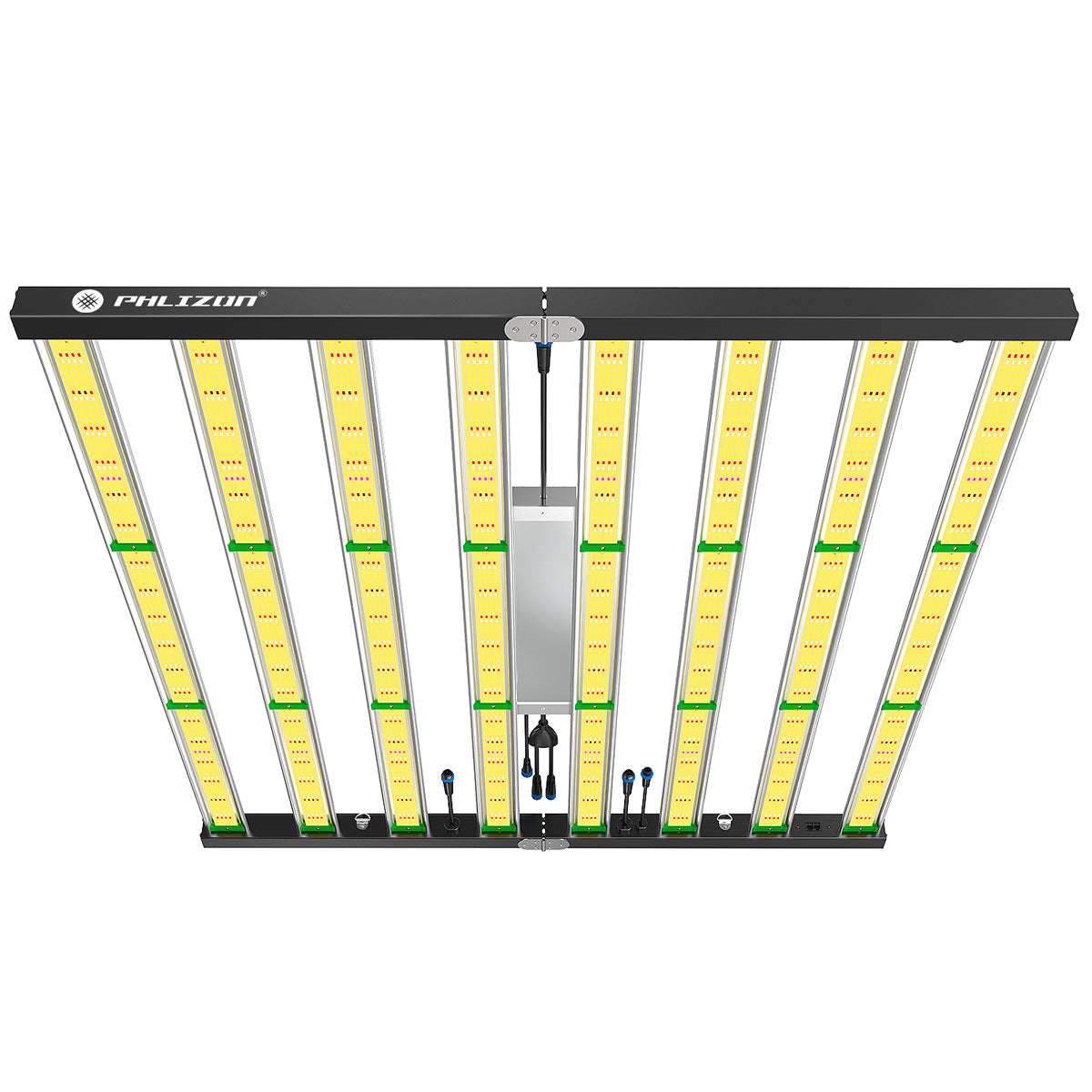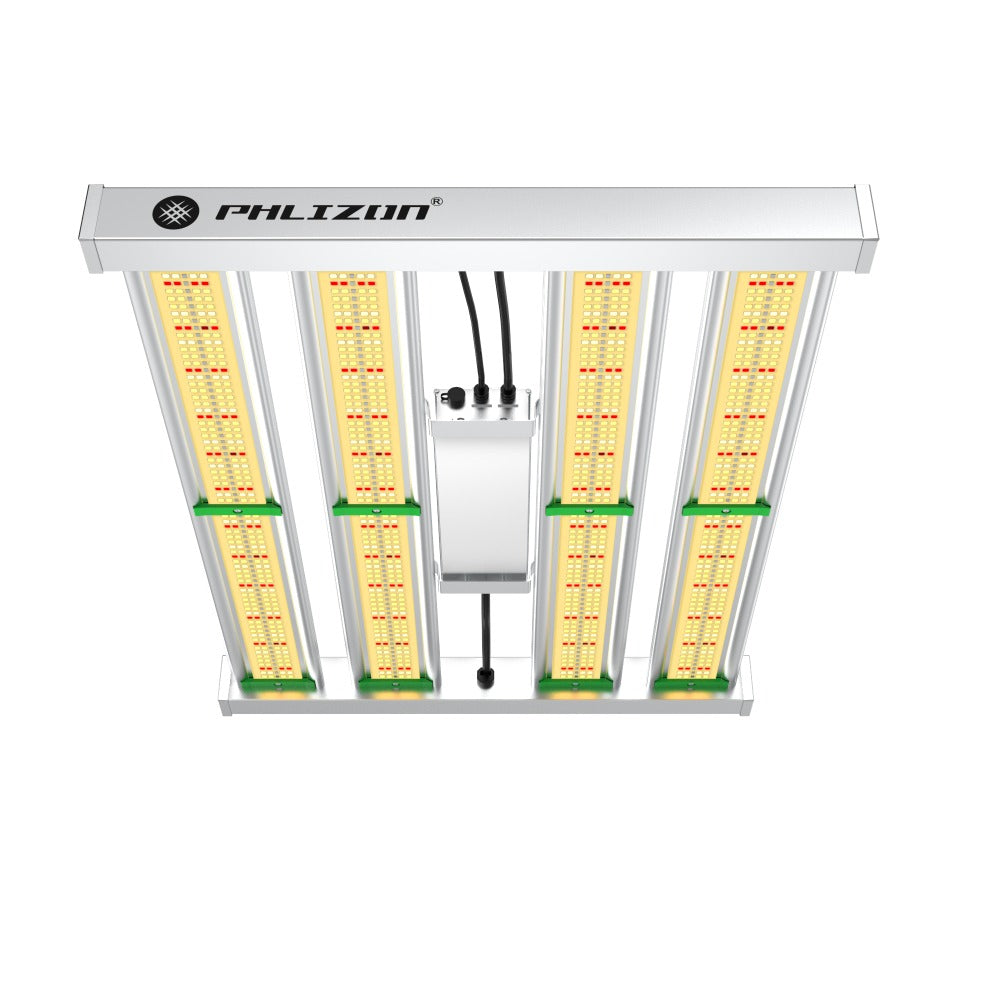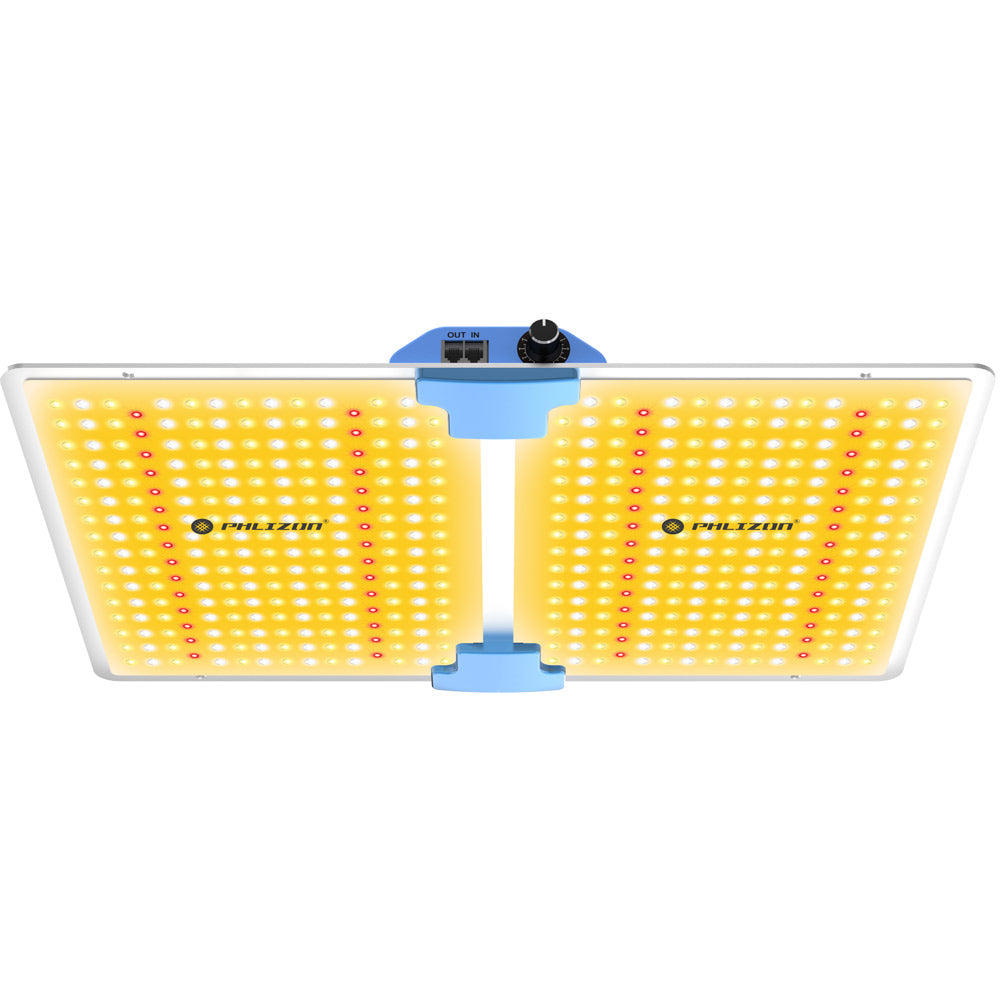Menu
Does the Wavelength of Light Affect a Plant's Growth?
Light is one of the most critical factors influencing plant growth, driving processes like photosynthesis, photomorphogenesis, and photoperiodism. The wavelength of light, which determines its color and energy, plays a significant role in how plants develop, from germination to flowering. Different wavelengths trigger specific physiological and morphological responses, affecting everything from leaf size to root development and yield. This article explores how various light wavelengths impact plant growth, drawing on detailed insights from horticultural research.
The Role of Light in Plant Growth
Light is an essential factor in maintaining plants. The rate of growth and length of time a plant remains active is dependent on the amount of light it receives. Light energy is used in photosynthesis, the plant’s most basic metabolic process.
When determining the effect of light on plant growth there are three areas to consider: intensity, duration and quality. Light intensity influences the manufacture of plant food, stem length, leaf color and flowering. Generally speaking, plants grown in low light tend to be spindly with light green leaves. A similar plant grown in very bright light tends to be shorter, better branched, and have larger, dark green leaves.
Plants can be classified according to their light needs, such as high, medium and low light requirements. The light intensity received by an indoor plant depends upon the nearness of the light source to the plant. Light is a form of radiation, which takes the form of electromagnetic waves that pass through air or vacuums.
It can therefore be described in terms of three physical properties: intensity (or amplitude), frequency (or wavelength) and direction of vibration (polarization). When we describe the electromagnetic or light spectrum, it’s better to talk about wavelength than about color. That’s because visible light for humans comprises only a small portion of the light spectrum as a whole – namely the range of wavelengths between 400 and 700 nanometres (nm, which is 10-9 m).
Photosynthetically Active Radiation (PAR)
Plants primarily respond to wavelengths from 400-700 nanometers (nm) for photosynthesis; light within these wavelengths is referred to as photosynthetically active radiation (PAR). The various wavelengths of light in the spectrum can trigger morphological responses. Light spectrum in terms of plant growth and morphology is often referred to as light quality, and collectively these responses to light are called photomorphogenesis.
The peak of photosynthetic efficiency (light absorption) falls in the red light and blue light spectrums of the PAR range. Red radiation (around 700nm) is considered most efficient at driving photosynthesis – especially in the flowering stage for biomass growth. Blue light is essential for both the vegetative and flowering stages of plant growth, but mainly for establishing vegetative and structural growth.
Specific Wavelengths and Their Effects
Ultraviolet Light (280-400 nm)
While UV (280-400nm) does not play a role in the growth of a plant it may have a role in the activation of a plants’ defense mechanism. Although damaging in large quantities, UV light can have important benefits such as producing different defense proteins that give them protection against pests and disease. Plants are also able to increase antioxidant compounds to protect themselves against UV light damage, and many of these also add to the nutritional value of the plant. Researchers have found that UV-B wavelengths in the 280-315nm range can also play a role in the development of flavonoids and phenolic acids.
UVA and near ultraviolet light from 315-400 nm is considered one of the longest UV light wavelengths and it can enhance plant pigmentation, thicken leaves and may even help manage insect populations. It’s at this wavelength that chlorophyll absorption starts and light is used to manage plant architecture and long-term health.
Studies show that 385 nm UV light promotes the accumulation of phenolic compounds, enhances antioxidant activity of plant extracts, but does not have any significant effect on growth processes. UVB has also been demonstrated to elevate THC levels in Cannabis.
Blue Light (400-500 nm)
Blue light is essential during a plant’s germination phase. Stronger concentrations of blue light will encourage sprouting and development of strong roots. With a wavelength between 400-500nm, this light has high energy and affects the leaf growth (also called vegetative or “veg” growth) of plants. Blue light has an impact on chlorophyll production, but you only need it in very small quantities when compared to red light. If a plant does not get enough blue light, it will start getting weaker, with yellow streaks in the leaves instead of green.
A larger proportion of blue light has an inhibitory effect on cell elongation, which leads to shorter stems and thicker leaves. Conversely, a decrease in the amount of blue light will cause a larger leaf surface area and longer stems. Too little blue light will negatively affect the development of plants. Many plants need a minimum amount of blue light, which ranges from 5 to 30 μmol/m2/s for lettuce and peppers to 30 μmol/m2/s for soybean.
From 440-500 nm this light plays a major role in plant quality and is needed to ensure that plant development is optimal, and optimised. This light, when used in conjunction with the other wavelengths ensures that the plant’s roots are developed properly, that growth is managed correctly, and that chlorophyll absorption is maximised. At this light wavelength leafy plants really do benefit the most.
Green Light (510-610 nm)
Green light is generally reflected away from plants (which is why they appear green), but plants will absorb a small amount of green light throughout the photosynthesis process. Green wavelengths have been somewhat written off as less important for plant photosynthesis given its (in)ability to readily absorb chlorophyll compared to red or blue light spectrums. Nonetheless, green is still absorbed and used for photosynthesis; in fact, only 5-10% is actually reflected – the rest is absorbed or transmitted lower down! This is due to green light’s ability to penetrate a plant’s canopy.
Most green light is reflected off the plant and plays a much smaller role in plant growth. However, there are some important aspects of light in this range so a certain amount of light in this spectrum range is beneficial. Green light is sometimes used as a tool for eliciting specific plant responses such as stomatal control, phototropism, photomorphogenic growth and environmental signaling. When combined with blue, red and far-red wavelengths, green light completes a comprehensive spectral treatment for understanding plant physiological activity.
Research conducted on lettuce also shows that plant growth and biomass increased when 24% green light was added to a red-blue LED, while maintaining equal PAR levels (150 μmol/m2/s) between the two objects. This indicates that even green light can have a positive influence on plant growth.
Red Light (600-700 nm)
Red light is known to be the most effective light spectrum to encourage photosynthesis as it’s highly absorbed by chlorophyll pigments. In other words, it sits in the peaks in chlorophyll absorption. Red light wavelengths (particularly around 660nm) encourage stem, leaf, and general vegetative growth – but most commonly, tall, stretching of leaves and flowers.
This low-energy light has a wavelength of 600-700nm. It is essential for flowering and blooming of the plants. Deficiency in this light wavelength will invariably result in delayed flowering or very weak blooming stage in plants. Red light affects phytochrome reversibility and is the most important for flowering and fruiting regulation.
The 660nm wavelength has a very strong photosynthetic action. It exhibits the highest action on red-absorbing phytochrome regulated germination, flowering and other processes. This wavelength is most effective for light cycle extension or night interruption to induce flowering of long-day plants or to prevent flowering of short-day plants.
610-700 nm is considered the optimum wavelength for chlorophyll absorption, germination and flower or bud development. This wavelength is perfect for flowering and for photoperiodism. This light, when balanced with blue and green light, can translate into perfect plant growth and optimised yield.
Far-Red Light (700-800 nm)
Although the 730nm wavelength is outside the photosynthetically active range, it has the strongest action on the far-red absorbing form of phytochrome, converting it back to the red-absorbing form. Plants requiring relatively low values of the phytochrome photoequilibrium to drive the flower cycle. 700-800 nm increases the rate of photosynthesis and recent research has found that this can promote extension growth and has myriad benefits. This is proving to be one of the more interesting wavelengths recently and can be supported by the intelligent use of LED grow lights.
Far-red will also have the opposite effect to blue light on root to shoot ratio, resulting in higher shoot to root distribution. Yet, as with all elements of the light spectrum, there is a balance to be struck between a beneficial amount of far-red light and too much. Plants grown under high levels of far-red light will appear tall and stretched, with lower chlorophyll content resulting in yellowing of the leaves, which is perhaps unfavourable from a marketability perspective.
Balancing Light Spectra for Optimal Growth
Plants need both red and blue spectrum light to flourish at different stages of growth and to bloom. In an indoor grow system, you will have to pick artificial grow lights capable of fulfilling all three factors. Of these, the duration is the easiest to replicate, as you just have kept the lights on for a set period. Intensity can be a challenge with some grow lights.
Growers change light intensity by changing the distance between the plant and the light bulb. The closer the light source, the more intense the light. The problem here is that many grow lights also emit a lot of heat. So if you place the bulbs too close to the plants, they may wilt or die. So a careful balance has to be maintained. Wavelength is another challenging aspect. The sun is a perfect single source that radiates enough energy for the plants in all the wavelengths, blue and red.
After seeing how different wavelengths are responsible for different plants reactions, it is easy to see why full-spectrum lights are the best for plant growth. Full-spectrum light most closely mimics the natural sunlight by using a combination of all colors at all stages of growth. Excluding certain wavelengths that contribute to plant growth can negatively affect yields. When horticulture LED grow lights were first introduced in the market, they only included produced light in the red and blue wavelengths which led to them being known as “smurf” lights. While this is true, more recent studies have shown that adding green light to an LED grow light actually increases crop yields compared to fixtures focused entirely on red and blue light.
Practical Applications in Horticulture
Many growers take advantage of LED lights to help scale plant production due to their full light spectrum capabilities, low heat waste and maintenance, and extended lifespan. And given a plant’s physiology and morphology are strongly affected by specific spectrums, LED grow lights can efficiently promote growth in crops at specific times in the growth cycle. With the ability to closely monitor quality, energy output can be easily evaluated for scaling crop production.
As LED lighting technology develops it is increasingly possible to alter the composition of light, to select individual wavebands or to alter the proportion of specific wavelengths, in order to elicit a targeted growth response in plants. The ability to manipulate the composition of light, and an understanding of the biological mechanisms at the heart of plant responses to different light compositions and availabilities, can therefore be used to ‘instruct’ plants as to how you want them to grow.
The motivations for doing this are varied, but the principal reasons will either be to increase the amount of biomass produced, and therefore overall yield, to alter the shape and appearance of the plant, or change its chemical composition, to make it more appealing to a customer and therefore more commercially attractive. The selection of spectra can be complex however, as including, or excluding, light from a given wavelength will have both direct effects and indirect effects.
Case Studies: Lettuce and Other Crops
The results of this study showed that the growth, photosynthesis, and antioxidant activity of lettuce performed better with a combination of blue light with a peak wavelength of 435 nm and red with a peak wavelength of 663 nm with a ratio of (1.25 ± 0.1), than with a combination of blue light with a peak wavelength of 450 nm and red with a peak wavelength of 663 nm with a ratio of (1.25 ± 0.1) at high intensity of (270 ± 20 µmol m−2 s−1).
When a small amount of green light with a wavelength peak at 520 nm is added to the combination of B450/R663 nm and the ratio of B450 nm to Red663 nm is the same or R663/B450 nm = 1.2, all of the LEDs enhanced the assimilation rate by the same amount and produced the same amount of lettuce fresh weight. From these results, it can be concluded that B435/R at high intensity is the best LED for the production of economic yields of hydroponically grown lettuce in the plant factory for production of the highest yields.
In this study, the effects of green light-emitting diodes (LEDs) with different peak wavelengths and light intensities on lettuce growth and photosynthesis were evaluated.
The green LEDs used were G510 (peak wavelength: 510 nm; band width at half peak height: 18 nm), G520 (524 nm; 30 nm) and G530 (532 nm; 36 nm) at a photosynthetic photon flux (PPF) of 100, 200 and 300 μmol m−2 s−1, respectively (maximum output of G530 was PPF 260).
Shoot and root growth in lettuce plants irradiated with green LED light at PPF 100 decreased compared with white fluorescent light, but root growth of plants irradiated with green LED light at PPF 200 increased, and shoot growth of plants grown under G510 at PPF 300 was the highest of all light sources. Leaf photosynthetic rate (Pn) of plants irradiated with green LED light at PPF 200 was dramatically higher than that at PPF 100, and the Pn of plants irradiated with G510 was the highest of all light sources.
These results indicated that high-intensity green LED light was effective to promote plant growth and, in particular, short-wavelength green light was available for active plant growth.
View our products:
- https://www.phlizonstore.com/collections/grow-light-with-uv-ir-led
- https://www.phlizonstore.com/products/phlizon-fd8000-1000w-upgraded-foldable-led-grow-light-bar
- https://www.phlizonstore.com/products/phlizon-pl1000-qb-full-spectrum-led-grow-light-with-samsung-lm301b-leds
- https://www.phlizonstore.com/products/phizon-fd6000-640w-upgraded-foldable-led-grow-light-bar
- https://www.phlizonstore.com/products/phlizon-pro-series-2000-led-grow-bar-lights
FAQs
1. Why is blue light important for plant growth?
Blue light (400-500 nm) is critical for vegetative growth, promoting strong roots, compact plants, and chlorophyll production. It inhibits cell elongation, leading to shorter stems and thicker leaves, which is essential for healthy seedlings and leafy plants.
2. How does red light affect flowering?
Red light (600-700 nm) is vital for flowering and fruiting, as it enhances chlorophyll absorption and triggers phytochrome-mediated processes. It promotes stem elongation and is most effective at around 660 nm for inducing flowering in long-day plants.
3. Is green light useless for plants?
No, green light (510-610 nm) is not useless. While plants reflect much of it, 5-10% is absorbed for photosynthesis. Green light can penetrate canopies, aiding lower leaves, and studies show it boosts biomass when added to red and blue light.
4. Can UV light benefit plants?
In small amounts, UV light (280-400 nm) can enhance plant defenses, increase antioxidant compounds, and improve nutritional value. UV-B (280-315 nm) may boost flavonoids, while UVA (315-400 nm) enhances pigmentation and leaf thickness.
5. What is the best light spectrum for plant growth?
Full-spectrum light, mimicking natural sunlight, is ideal as it provides all wavelengths needed for various growth stages. A balanced mix of blue, red, and some green light optimizes photosynthesis, morphology, and yield.
6. How does far-red light influence plants?
Far-red light (700-800 nm) promotes stem elongation and can increase photosynthesis rates. It affects phytochrome balance, influencing flowering and shade avoidance responses, but excessive amounts may cause undesirable stretching.
7. Do different plants need different light spectra?
Yes, plant species and varieties respond differently to light wavelengths. For example, lettuce benefits from specific blue-red ratios, while kale and basil may require different proportions for optimal carotenoid accumulation.
8. Can LED grow lights replicate sunlight?
LED grow lights can closely mimic sunlight by providing full-spectrum or tailored wavelengths. They allow precise control over light quality, intensity, and duration, making them effective for indoor horticulture, though sunlight remains unmatched in quality.
Conclusion
The wavelength of light profoundly affects plant growth, with each spectrum triggering distinct responses. Blue light drives vegetative growth, red light fuels flowering, green light aids canopy penetration, UV light boosts defenses, and far-red light influences elongation.
Full-spectrum lighting, especially via advanced LED systems, offers the best approach to optimize plant health and yield, closely replicating natural sunlight. Understanding these effects empowers growers to tailor light conditions for specific crops and growth stages, maximizing productivity and quality.
Featured blog
- Choosing a selection results in a full page refresh.

















